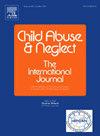不良童年经历(ACEs)与情绪失调表型:美国全国代表性样本中种族/民族和性别的交叉分析。
IF 3.4
2区 心理学
Q1 FAMILY STUDIES
引用次数: 0
摘要
背景:童年不良经历(ACEs)是青春期情绪失调的强大、可预防的风险因素,但ACEs与情绪失调的关联是否因种族/民族或性别而异仍不清楚:我们研究了(a)种族/民族和性别如何共同影响潜在的 ACEs 类别和情绪失调表型,以及(b)这些童年时期(9 岁前)的 ACEs 类别如何过渡到青春期(15 岁时)的潜在情绪失调表型:参与者是来自 "家庭未来与儿童福祉研究"(Future of Families and Child Wellbeing Study)两波数据中的 3273 名儿童。样本包括 26.6% 的非西班牙裔黑人男孩、25.4% 的非西班牙裔黑人女孩、12.9% 的西班牙裔男孩、12.6% 的西班牙裔女孩、11.8% 的非西班牙裔白人男孩和 10.7% 的非西班牙裔白人女孩:我们估计了潜类模型,以确定十个指标的 ACE 模式以及情感、注意力和行为领域的失调表型。结果:研究结果表明,从童年到青春期,ACE 类是如何过渡到调节障碍表型的:结果:研究结果表明,在种族/族裔和性别的交叉点上,ACEs 和情绪失调的潜在类别在数量和性质上都存在很大差异。与新罕布什尔州的白人儿童相比,新罕布什尔州的黑人和西班牙裔儿童更有可能属于贫困和父母离异类别。西语裔男孩出现严重失调的比例最高(16%),而新罕布什尔州白人男孩出现低症状的比例最高(52%)。贫困和父母离异类别的儿童转入低症状类别的概率较高。相比之下,受虐待和家庭功能失调类别的人更有可能过渡到严重失调类别,其中北荷兰白人女孩的概率最高(0.34),几乎是北荷兰黑人女孩(0.19)的两倍。在这些过渡概率中,白人存在性别差异,而黑人则没有:因此,这些发现突出表明,在研究 ACE 对青少年成长的影响时,有必要采用一种交叉的、以人为本的方法。本文章由计算机程序翻译,如有差异,请以英文原文为准。
Adverse childhood experiences (ACEs) and emotion dysregulation phenotypes: An intersectional analysis of race/ethnicity and gender in a nationally representative U.S. sample
Background
Adverse childhood experiences (ACEs) are strong, preventable risk factors for emotion dysregulation in adolescence, but whether ACEs-emotion dysregulation associations differ by race/ethnicity or gender remains unclear.
Objective
We examined (a) how race/ethnicity and gender jointly impact latent ACEs classes and emotion dysregulation phenotypes, and (b) how these ACEs classes in childhood (by age 9) transition to latent emotion dysregulation phenotypes in adolescence (at age 15).
Participants and setting
Participants were 3,273 children from two waves of data from the Future of Families and Child Wellbeing Study, a large, nationally representative cohort. The sample consisted of 26.6% non-Hispanic (NH) Black boys, 25.4% NH Black girls, 12.9% Hispanic boys, 12.6% Hispanic girls, 11.8% NH White boys, and 10.7% NH White girls.
Method
We estimated latent class models to identify ACEs patterns across ten indicators and dysregulation phenotypes across affective, attentional, and behavioral domains. Latent transition analysis was used to examine how ACEs classes transitioned into dysregulation phenotypes from childhood into adolescence.
Results
The findings revealed significant variation in the number and nature of latent classes of both ACEs and emotion dysregulation across the intersection of race/ethnicity and gender. NH Black and Hispanic children were more likely to be in the Poverty and Parental Separation class than NH White children. Hispanic boys had the highest prevalence of Severe Dysregulation (16%), whereas NH White boys had the highest prevalence of Low Symptoms (52%). Individuals in the Poverty and Parental Separation class had a higher probability of transitioning to the Low Symptoms class. In contrast, those in the Abuse and Family Dysfunction class were more likely to transition to the Severe Dysregulation class, with NH White girls showing the highest probability (.34), nearly twice that of NH Black girls (.19). These gender differences in these transition probabilities were observed for Whites but not Blacks.
Conclusions
These findings thus highlight the need for adopting an intersectional, person-centered approach when studying the effects of ACEs on adolescent development.
求助全文
通过发布文献求助,成功后即可免费获取论文全文。
去求助
来源期刊

Child Abuse & Neglect
Multiple-
CiteScore
7.40
自引率
10.40%
发文量
397
期刊介绍:
Official Publication of the International Society for Prevention of Child Abuse and Neglect. Child Abuse & Neglect The International Journal, provides an international, multidisciplinary forum on all aspects of child abuse and neglect, with special emphasis on prevention and treatment; the scope extends further to all those aspects of life which either favor or hinder child development. While contributions will primarily be from the fields of psychology, psychiatry, social work, medicine, nursing, law enforcement, legislature, education, and anthropology, the Journal encourages the concerned lay individual and child-oriented advocate organizations to contribute.
 求助内容:
求助内容: 应助结果提醒方式:
应助结果提醒方式:


